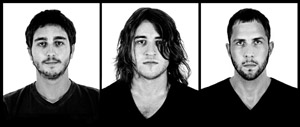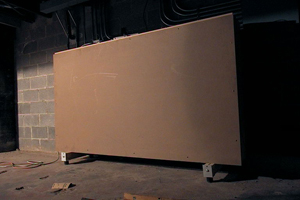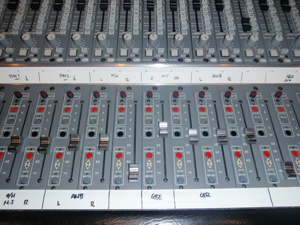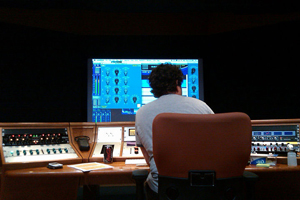How Grandfather Made A Record With Steve Albini In Three Days, Part III
[Part III of a three-part series by Grandfather guitarist Michael Kirsch. Start with Part I here!]
With one song left to record, Jon Silverman (bass) and I were almost done with our performance duties; Josh Hoffman, our drummer/singer still had all of his vocals left to perform.
We entered the studio and knocked out the final song of the session, “Tremors.” While we had played these songs hundreds of times in rehearsal, the performances at Electrical Audio would be cemented forever as the definitive versions of our songs. This was both exciting and nerve-wracking, however, everyone agreed it was time to move on to the vocals, and not look back.
VOCALS
During our live shows Josh sings while drumming. Nevertheless, we decided to overdub the vocals in the studio. This was primarily for technical reasons: we wanted to have more control of the vocal in the mix, separate from the drums.
Albini’s approach to recording vocals was organic. Using two microphones and an actual metal plate reverb, he set up a vocal chain that would respond to Josh’s voice dynamically and in real-time.
Ordinarily in a lively, reverberating acoustic chamber, the depth and quality of reverb would be directly related to the volume of the voice. A quiet vocal would have minimal reflections whereas a loud, belting vocal would resonate more. In order to capture this on tape, a Crown PCC microphonewas setup on the floor of Center Field.
Josh stood in Kentucky, facing Center Field with the door open. The Crown mic was keyed to an expander set to only turn on when he sang loudly. This technique can be heard clearly on our song “You’re Strange.” (Download here — at approximately 3:53, and 4:07 you can hear the Crown mic turn on.)
A Neumann U48 was used as a close mic, capturing all the delicate detail and nuance of Josh’s voice. The vocal was chain was also bussed out to an original Echoplate reverb, built in 1969.
The Echoplate is a large mechanical unit that uses a large sheet of steel, a transducer and contact microphones to create and record reverberation. The voice is sent through a transducer, which vibrates the steel sheet. The resonance is then recorded by the contact mics. The Echoplate provided a rich yet realistic sonic space for the vocal in the mix.
MIXING
We mixed all nine songs over the next two days, in between vocal breaks. The process was relatively simple. Mixing primarily consisted of setting fader levels to balance the relative volume of the tracks. A minimal amount of compression and EQ was used prior to us recording, minimizing the need for any extra use in the mix.
The frequency balance, overall tone and ambience would be set using the volume faders on each track. If the bass required more brightness to fit in the mix, the brighter mic would be brought up in level. If the guitar needed more ambience, the room mic would be brought up.
The goal of a mix is a cohesive recording, where the parts can he heard clearly and the dynamics of the song are preserved. Rather than drastically altering the recordings to make them sound and fit “better,” the inherent qualities of the instruments and voice were balanced carefully.
We took a hands-off approach during the mixing stage. We understood that Albini knew his monitors and equipment much better than we did. We also felt he had an objective lens as to what the band actually sounded like; whereas we had preconceived notions, and an attachment to how we heard things in our heads.
He had been listening to us for three days straight, and seemed to understand what we were trying to accomplish. There were a couple of moments where we made suggestions, and he obliged without question, but overall, we felt the performances provided enough information to dictate what kind of sonic space our music should occupy.
MASTERING
After three incredibly long days at Electrical Audio, we had mixed down all nine songs. With reels of tape in hand, we left the studio. It felt surreal. We could not believe how quickly the sessions went by.
We had a mastering session scheduled for the following day with Bob Weston at Chicago Mastering Service. We figured he would have the best ears for mastering our record, considering that he plays in the band Shellac along with Albini, and has been mastering records made at Electrical Audio for years.
Chicago Mastering is a small facility with a big sound. The mastering room is acoustically treated to create an extremely accurate and high-resolution listening environment.
Utilizing a custom-built mastering console filled with vintage EQs and compressors, Weston brought out all of the subtleties of our recording, but without over-compressing the dynamics. Modern records tend to be mastered for the loudest possible signal, which often destroys the dynamics of the performance. Weston was careful not to sacrifice anything just for the sake of volume.
The attended mastering session lasted about four hours. We left Chicago the following day with a digital copy of our album. Chicago Mastering would also be cutting our lacquers for the 12” vinyl record that week, and send them out to be plated and pressed into a limited run of 300 vinyl records.
– Michael Kirsch, Guitarist, Grandfather
Download Why I’d Try for FREE on Grandfather’s website: http://grandfathermusic.com. Email any questions to info at grandfathermusic dot com.











Gregovertone
October 26, 2010 at 3:08 am (14 years ago)great read!